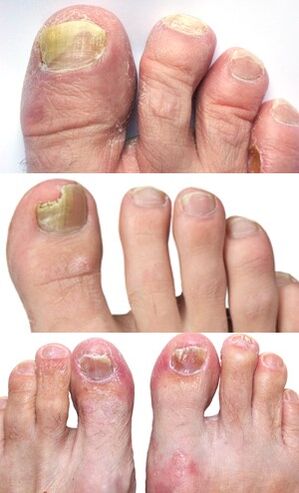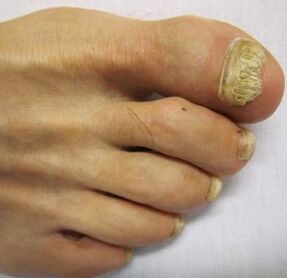The fungus damages part and all of the nail, including the nail plate, the bed, and the root of the nail. The infection develops slowly, causing the nail to change color, thicken and bend. Concomitant symptoms may include skin lesions of the fingers, peeling, itching and redness. Over time, the nails become so deformed that they interfere with wearing normal shoes, for example.
Most often, the fungus affects the toenails. The medical name is onychomycosis. It is mainly found in older people and is rare in children. In most cases, nail mycosis is caused by the dermatophyte fungus, which also affects the skin. Sometimes the disease is caused by other types of fungi.
In mild cases, nail treatment is not necessary. The dermatologist analyzes the cut nail to determine the exact cause of the infection and to rule out other possible diseases. Nail fungus can be cured, but sometimes it takes several months. Antifungal drugs come in the form of tablets and nail polishes. In the case of advanced nail fungus, surgical removal of the nail is resorted to. There is also a laser treatment method.
Signs and symptoms of nail fungus
The most common symptom of onychomycosis is discoloration and deformity of the nail. Your nails may turn white, black, yellow or green. As a general rule, nail fungus does not cause much concern at first and in most cases has no complications. If the infection is not treated, pain can develop in the affected nail. Nail fungus makes it difficult to walk and wear shoes, and if it touches your nails, it can be difficult to write.
With the onset of onychomycosis, other symptoms also appear, such as the nail may become brittle, loose, or peel off the nail bed completely. Without treatment, the fungal infection can spread to the skin of the fingers and the interdigital spaces. White or yellow spots may appear on the nail bed and the skin around the nail may come off. All these changes can be seen in the photo of the nail fungus.
Causes of nail fungus

The most common cause of nail damage is a fungal infection of the skin, such as the fungus. Usually, fungus develops on the skin between the toes, causing it to be red, flaky and itchy. The fungus grows and multiplies rapidly in a warm, humid environment, so prolonged wearing of shoes or sweaty feet increases the chances of developing an infection. About a third of people with foot fungus experience nail deterioration.
Nail fungus can be caused by an infection caused by yeast candida, which is also guilty of diseases such as vaginal thrush or stomatitis. Nail fungus is more likely to develop if a person has to wash their hands frequently at work or keep their hands in water for a long time. Moisture exfoliates the skin at the base of the nail, making it easier for fungi to access the nail. There is a higher risk of developing candidate nail lesions in certain diseases, namely:
- diabetes mellitus or psoriasis;
- weakened immunity to, for example, HIV;
- poor general health.
Other factors that may increase the risk of developing nail fungus include:
- wearing false nails;
- nail damage;
- constant biting of nails;
- living in a warm, humid climate;
- smoking.
As you age, the likelihood of nail fungus developing increases. Sometimes the fungus appears for no apparent reason.
Nail fungus treatment
In mild cases, treatment is not required. However, if left untreated, the infection can spread to other nails as well as the skin of the toes and hands. In order to get rid of mycosis of the nails as soon as possible, it is important to follow simple rules: give up shoes with sweaty feet, cut off the nails and carefully check the hygiene of the feet.
Using the medications, a new, healthy nail begins to grow at the base of the nail bed, indicating that the treatment is helping. The old affected nail gradually grows back and can be cut off within a few months. If after 2-3 weeks of treatment the new nail does not start to grow, you should see a doctor. It is impossible to stop taking the prescribed medications without consulting a doctor as this can lead to a recurrence of the infection.
Foot care tips against nail fungus
Below you will find tips for controlling the infection during and after treatment.
- keep your feet dry and cool, socks and shoes should allow your feet to "breathe";
- wear clean cotton socks and try to wear sneakers as little as possible;
- start treating the fungus on the first signs of damage to prevent the infection from spreading to the nails;
- cut the nails correctly;
- remove the affected areas of the nails with separate scissors to avoid spreading the infection;
- wear shoes of the right size with low heels and wide toes;
- putting on clean slippers in a public shower;
- if it is difficult to walk due to thickened nails, consult a dermatologist;
- it is advisable to get rid of old shoes contaminated with fungal spores.
Medicines against nail fungus

When you take an antifungal tablet, the medicine reaches your nails through the bloodstream. Terbinafine and itraconazole are most commonly prescribed for nail fungi, which are very effective drugs. However, complete elimination of the infection requires several months of therapy. If treatment is not completed, the infection may return.
The advantage of the tablets is that they help to eliminate all related fungal infections, such as foot fungus, at the same time. Possible side effects of antifungal tablets:
- headache;
- itchy;
- loss of taste;
- nausea;
- diarrhea.
Local remedies for nail fungus
Antifungal nail polish can be used instead of tablets. It is not as effective as the tablets because the medicine is applied to the affected nail and has to get to the site of infection through it. It is often not possible to cover the entire lesion. Hand nail treatment can take about six months, on the nail - up to a year.
Use a paste containing 40% urea to remove the affected nail plates. This paste is sold without a prescription. In the evening, the paste is carefully applied to the affected nails, which are then covered with a bandage overnight. The paste is washed in the morning and in the evening the nails are filed according to the instructions and the procedure is repeated. In about two weeks, the nails affected by the fungus dissolve.
This is a painless procedure that allows you to remove the affected nail plate and get rid of the fungus. Avoid months of medication and painful surgery. After the nail plate has dissolved, antifungal varnish should be applied to the nails twice a week to prevent new nails from becoming infected.
Surgery and laser treatment for onychomycosis
In case of advanced nail fungus or severe pain, surgical removal of the nail is recommended if other treatments fail. After surgery, over time, the removed nail is replaced by a new woman, but this can take a year or more.
Another method of treating advanced nail fungus is laser treatment. The laser emits a huge amount of light energy that kills the fungus. Research has shown that this treatment method is safe and effective, with some studies achieving 90% efficacy after 3 months. However, little data are available on the long-term efficacy of the method, as most studies only followed people for 3 months. To achieve lasting results, it should be treated every 3 months for up to a year. This procedure can be costly.
The need for treatment and the choice of medication should be consulted with a dermatologist. Once the infection is gone, the nail cannot return to its original appearance. In these cases, nail pieces are analyzed to determine if the infection persisted in the thickness of the nail despite treatment.

























